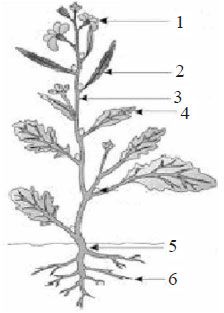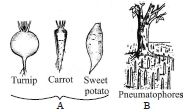Prop roots of banyan tree are meant for
respiration.
absorption of water from soil.
providing support to big tree.
all of the above.
Correct Answer :
C. providing support to big tree.
Some plants are profusely branched and branches are thick and heavy. From these branches roots arise and hang downwards in the air and later penetrate the soil and function as prop (for support) to the branch, e.g., Ficus bengalensis (Banyan).
Related Questions
Identify the different types of aestivation (A, B, C and D) in corolla and select the correct option.

A-Valvate, B-Twisted, C-Imbricate, D-Vexillary
A-Vexillary, B-Valvate, C-Twisted, D-Imbricate
A-Imbricate, B-Vexillary, C-Valvate, D-Twisted
A-Twisted, B-Imbricate, C-Vexillary, D-Valvate
Which of the following option shows the correct labelling of the parts of leaf marked as A, B, C and D.

A - Lamina, B - Axillary bud, C - Stipule, D - Leaf base
A - Lamina, B - Stipule, C - Axillary bud, D - Leaf base
A - Lamina, B - Axillary bud, C - Stipule, D - Pedicel
A - Leaflet, B - Axillary bud, C - Stipule, D - Leaf base
Aleurone layer helps in
storage of food in endosperm.
protection of embryo.
utilization of stored food.
all of the above.
Statement 1 : A simple leaf has undivided lamina.
Statement 2 : Leaves showing pinnate and palmate venations have various type of incisions.
Statement-1 and statement-2 are true and statement-2 is a correct explanation for statement -1.
Statement -1 and statement -2 are true but statement-2 is not a correct explanation for statement-1.
Statement-1 is true and statement-2 is false.
Both the statements are false.
During the post-fertilization period, the ovules develops into ___A____ and the ovary matures into a ___B ____.
A - seeds; B - fruit
A - fruit; B - seeds
A - flower; B - seed
A - seeds; B - flower
The given figure shows the parts of mango and coconut. Choose the option which shows the correct labelling of A, B, C and D marked in the figures.

A - Epicarp, B - Mesocarp, C - Seed, D - Endocarp
A - Epicarp, B - Mesocarp, C - Ovule, D - Endocarp
A - Epicarp, B - Mesocarp, C - Ovary, D - Endocarp
A - Epicarp, B - Mesocarp, C - Embryo, D - Endocarp
Which of the following statement(s) is/are correct about venation?
(i) The arrangement of veins and the veinlets in the lamina of leaf is called venation.
(ii) Reticulate venation is the characteristic of monocots.
(iii) When the veinlets form a network, the venation is termed as reticulate venation.
(iv) When the veins run parallel to each other, within a lamina, the venation is termed as parallel venation.
Only (i)
Both (i) and (ii)
(i), (iii) and (iv)
All of these
Which of the following is not the characteristic features of fabaceae?
Tap root system, compound leaves and raceme inflorescence.
Flowers actinomorphic, twisted aestivation and gamopetalous.
Stamens 10, introrse, basifixed, dithecous.
Monocarpellary, ovary superior and bent stigma.
Fibrous root system is better adopted than tap root system for
transport of organic matter.
absorption of water and minerals.
storage of food.
anchorage of plant to soil.
Which part of plant is generally green when young and later often become woody and dark brown?
stem
seed
leaves
flower
Match column-I with column-II and choose the correct option.
| A. Gram, sem, moong, | I. Medicine soyabean |
|---|---|
| B. Soyabean,groundnut | II. Ornamental |
| C. Indigofera | III. Fodder |
| D. Sunhemp | IV. Fibres |
| E. Sesbania, Trifolium | V. Dye |
| F. Lupin, sweet potato | VI. Edible oil |
| G. Mulethi | VII. Pulses |
A I, B II, C III, D IV, E V, F VI, G VII
A VII, B VI, C V, D IV, E III, F II, G I
A II, B IV, C VI, D I, E III, F V, G VII
A I, B III, C V, D VII, E II, F IV, G VI
Which is not a stem modification ?
Rhizome of ginger
Corm of Colocasia
Pitcher of Nepenthes
Tuber of potato
The region of the stem where leaves are born are called ____________ while ____________ are the portions between two ____________.
nodes, nodes and internodes
nodes, internodes and nodes
internodes, nodes and nodes
internodes, internodes and nodes
Which of the following plants is growing in swampy areas, where many roots come out of the ground and grow vertically upwards?
Potato
Opuntia
Rhizophora
Grass
The given figure shows the parts of flowering plant. Which parts of the given figure were involved in the following functions:
- Storing reserve food material
- Synthesis of plant growth regulators.
- Absorption of water and minerals from the soil.
- Providing a proper anchorage to the plant parts

5 and 6
1, 2 and 6
1, 2, 3 and 4
2, 4, 5 and 6
A - Which one of the option shows the correct labelling of the parts marked as A, B, C and D in a typical structure of dicotyledonous seeds ?

A - Hilum, B - Micropyle, C - Radicle, D - Cotyledon, E - Plumule
A - Hilum, B - Micropyle, C - Plumule, D - Cotyledon, E - Radicle
A - Micropyle, B - Hilum, C - Plumule, D - Cotyledon, E - Radicle
A - Hilum, B - Micropyle, C - Plumule, D - Radicle, E - Cotyledon
Which of the following is an example of pinnately compound leaf ?
Cucumber
Papaya
Cucurbita
Neem
The given figures (A and B) shows the modificaiton of roots.Which of the following statements regarding the figures is correct ?

Tap roots of carrot, turnip and adventitious root of sweet potato, get swollen and store food.
Pneumatophores conducts water, minerals & photosynthesis
Pneumatophore is found in the plants that grow in sandy soil.
Turnip & carrot shows adventitious roots and sweet potato shows tap root.
X is the outermost whorl of the flower and contains Y. Y is green, leaf like and protect the other whorls of the flower. Identify X and Y.
X - Calyx; Y - Sepals
X - Corolla; Y - Petals
X - Gynoecium; Y - Fruit
X - Androecium; Y - Ovary
Read the following statements and answer the questions.
- Gynoecium is situated in the centre and other parts of the flower are located on the rim of the thalamus almost at the same level.
- Ovary is half-inferior.
- Examples are plum, rose and peach.
Which condition of flowers is being described by the above statements ?
hypogyny
perigyny
epigyny
none of these
Match the following placentation types given in column I with their examples given in column II and choose the correct combination from the options given below.
| (Placentation Types) | (Examples) |
|---|---|
| A. Basal | I. Dianthus |
| B. Free central | II. Pea |
| C. Parietal | III. Lemon |
| D. Axile | IV. Marigold |
| E. Marginal | V. Argemone |
A I, B II, C III, D IV, E V
A II, B III, C IV, D V, E I
A IV, B I, C V, D III, E II
A IV, B III, C V, D I, E II
Given figures (A, B and C) shows the position of floral parts on thalamus. (given as I, II and III) Select the correct combination.

- Hypogynous flower
- Perigynous flower
- Epigynous flower
A-I, B-II, C-III
A-I, B-III, C-II
A-III, B-II, C-I
A-III, B-I, C-II
Which of the following is the green expanded part of leaf with vein and veinlets?
Petiole
Node
Stipule
Lamina
The primary roots and its branches constitute the
fibrous root system.
tap root system.
adventitious root system.
all of the above
Alternate type of phyllotaxy is found in
china rose
mustard
sunflower
all of these
A branch in which each node bearing a rossette of leaves and a tuft of roots is found in aquatic plants like _________ and _________.
Hydrilla and Pistia
Eichhornia and Hydrilla
Pistia and Eichhornia
Pistia and Vallisneria
Which of the following statement(s) is/are correct about the fruit?
- Fruit is a mature or ripened ovary, developed before fertilization.
- It consists of a wall or pericarp and seeds.
- When pericarp is thick and fleshy, it is differentiated into outer mesocarp, middle epicarp and the inner endocarp.
- In mango and coconut, the fruit is known as a berry.
Only (i)
Both (ii) and (iii)
Only (ii)
All of these
Match the column-I containing types of aestivation with their examples given in column-II and choose the correct option.
| Column - I | Column-II |
|---|---|
| (Type of aestivation) | (Examples) |
| A. Valvate | I. Cotton |
| B. Twisted | II. Calotropis |
| C. Imbricate | III. Bean |
| D. Vexillary | IV. Gulmohar |
A I; B II; C IV; D III
A II; B I; C IV; D III
A II; B IV; C I; D III
A II; B I; C III; D IV
Identify the kind of phyllotaxy shown in the given figures A, B, and C.

A-Alternate, B - Opposite, C - Whorled
A- Whorled, B - Opposite, C -Alternate
A-Alternate, B - Whorled, C - Opposite
A-Whorled, B -Alternate, C - Opposite
Match the following stem modifications given in column I with their examples given in column II and select the correct combination from the options given below.
| (Stem Modifications) | (Found in) |
|---|---|
| A. Underground stem | I. Euphorbia |
| B. Stem tendril | II. Opuntia |
| C. Stem thorns | III. Potato |
| D. Flattened stem | IV. Citrus |
| E. Fleshy cylindrical stem | V. Cucumber |
A I, B II, C III, D V, E IV
A II, B III, C IV, D V, E I
A III, B IV, C V, D I, E II
A III, B V, C IV, D II, E I
